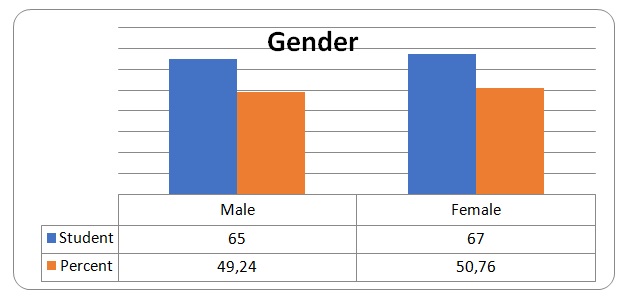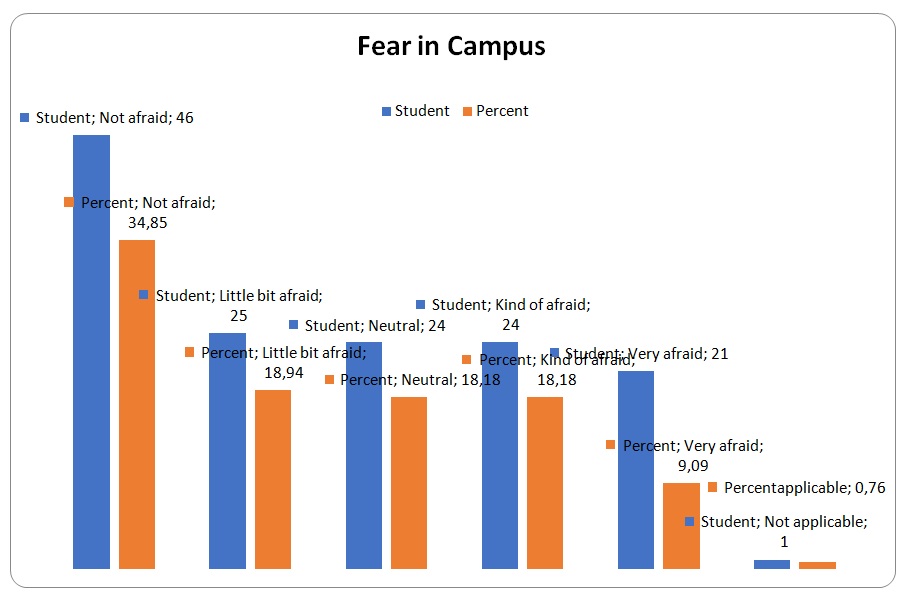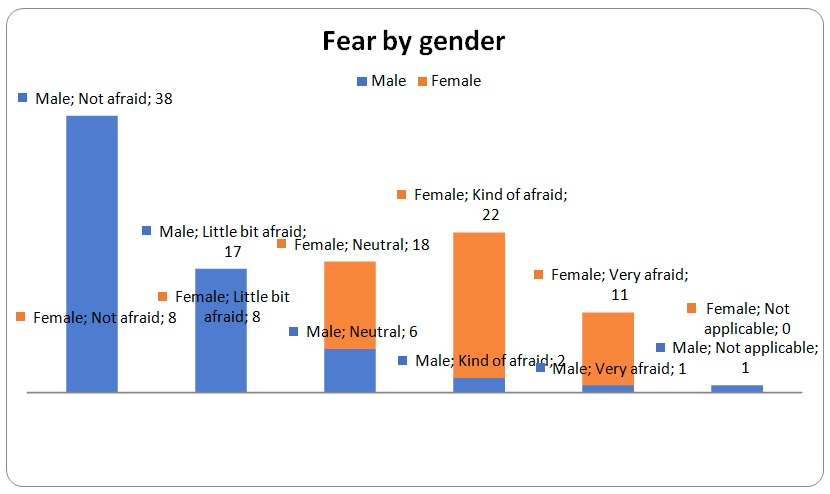Abstract
Security in universities has become a major concern in most parts of the world, with female students registering higher victimization levels compared to their male counterparts. Although most learning institutions share these experiences, it is worth noting that security in campus varies from one university to the depending on mitigation strategies put in place.
Colleges expose students to a completely new setting with unique challenges and expectations. Unlike at home where children are guaranteed security with their parents and family members, students are surrounded by new friends whom they may not be sure of being safe when they are around them. Consequently, many are shocked by the news around campus warning them to beware of high crime rates and to watch out for their security. Based on recent crime cases in campuses, there is fear variation based on gender differences among various students. This research paper examines the issue of fear of crime in campus and its variation between the sexes. The research further explores reasons behind these variations and measures which ought to be adopted in addressing the issue amicably.
Research hypothesis
Female students have a higher rate of fear of danger in campus than males. This is based on a number of factors which have been discussed in this research paper.
Literature review
Crime in campus has drawn the attention of many people around the world including leaders, educationists and authors. With increasing crime rates in most institutions of higher learning, stakeholders have taken it upon themselves to establish the causes of these alarming trends and possible understanding as to why ladies experience a lot of fear of victimization. This section of the research summarizes previous findings related to crime in campus with special emphasis on measuring the variation in fear between men and women as they are exposed to dangers during their study time in campus. To achieve this target, this research compares data and information from different authors in order to provide comparative information drawn from different authors around the world.
According to research, there is the need for alarm in cases where the security of students in campus is compromised or threatened. Even though there are fewer cases of shooting in most campuses, there are several forms of violence that students have to confront frequently while in session. With many campuses and other learning institutions recording low levels of fatal acts, it has to be double emphasized that some acts of violence are quite common in campuses around the world and cause fear among female and male students (Fisher 85). As a result, security has become a point of concern for most campuses with administrators finding ways of guaranteeing students security when they are away from their parents.
Despite high-security level, female students still experience high levels of fear of assault. This is considered as an abnormality since students needed to worry about succeeding in their studies and not about issues of criminal vulnerability. Understanding the fear among students is imperative since high levels of criminal fear may significantly affect their performance. Additionally, educationists and university management have to address the issue of unfounded fear to allow students settle in campus. It would be easier for preventive measures to be put in place to eliminate crime occurrence and reassuring students of their security through monitoring of events.
In addition, fear of crime in a campus has become a broad issue in the society. Violent incidences in campus include the fear of assault by friends or strangers, hate crimes and the fear of students being victimized of becoming casualties (Schafer 285). According to Del Carmen et al. 2000, there are certain changes that occur among students after they have experienced violent actions in campus. However, this approach was never applied since it was impossible to tell the time and place where the violence might have occurred. In a 2000 research, Del Carmen and his colleagues further note that crime is a common problem cutting across countless destinations.
Although the research conducted by Del Carmen and his colleagues was done among college students, the same could be observed in another campus setup. According to their findings, exposure of criminal activities to the public makes most students to feel insecure and vulnerable to more fatal actions (Del Carmen et al. 23). Furthermore, there has been an increase in criminal activities as illustrated by their research conducted in 2000 in which 9% of the participants represented an increase while perceived risks also recorded an increase of 5% with a higher magnitude being conceived among female participants (Del Carmen et al. 23, 2000). Occurrence of violence in campus usually puts the media in a dilemma because of the perceived impact that the information would have on students, their perception and fear while in school. The argument affirms that violent news in campus alters levels of being afraid (Heath and Gilbert 379).
Importantly, sociologists argue that any research that investigates a crime in campus has to incorporate major factors, which contribute to fear among students before and after violence has occurred. McConnell asserted that crime emerged as a social problem when President Lyndon B. Johnson mentioned that crime and fear of crime was already a public problem to deal with (McConnell 22). Although this was uttered in 1960s, there has been enough evidence to support the fact that crime in campus has continuously hit higher levels, a reality that could be attributed to wider societal issues. Since the time when crime data became public, in 1970s, many students have recorded higher fear percentages than before (Ferraro 669). However, some students note that the level of fear in an individual does not always reflect a corresponding likelihood of being victimized or experiencing an assault. For instance, a lot of researches done affirm that female students have higher levels of fear of criminal danger compared to their male counterparts who are perceived to be more prone to becoming crime victims. As such, documentation has integrated indicators of the general fear of victimization among students in campus.
While everybody may be at risk of being attacked by criminals, the fear that accompanies this notion makes it impossible to overcome the inner feeling and perception of being attacked at any given moment. For example, when serial killers are planning to attack, the fear of people automatically shoots up than when crime is occurring randomly in different parts of the city or country. In his 1996 survey, Ferraro supported the above analogy by identifying sexual assault as the main source of fear among female students in campus and other women elsewhere. It therefore means that female students feel sexually insecure as compared to other forms of victimization, which may take place in campus and its environs.
Consequently, Ferraro emphasized the need of comprehending risk interpretation procedures (Ferraro 670). In his 1996 analysis, Ferraro argued that there was need to have risk measured independently of fear in order to have substantive results. This is based on the fact that the degree of fear among students is normally generated by several offenses, and it is vital for a model to be developed that puts into consideration such cases. Moreover, ecological and personal characteristics affect the way individuals respond to fear and the perceived likelihood of victimization. These factors further determine the mode of adaptation, as people tend to master their security by addressing existing psychological fears. Since security is quite essential for everyone in the society, it has been found that majority of people are always fair when interpreting risks, which emanate from digested information (McPheters 47).
Another question that has been analyzed is the comparison between the fear of being attacked and the crime itself. Does a student who has fear suffer a lot compared to the one who has experienced an assault? Regardless of the case, it suffices to note that fear of victimization has its unique dangers that may differ from known effects of real crime in campus (Fisher 85). Aside from gender differences with regard to fear of crime, it is documented that age also affects the way people respond towards crime with those below the age of twenty five being at a considerable higher risk.
In general, the issue of crime in campus encompasses an array of discrepancies with several proposals indicating the causes of increasing criminal behavior in campus and possible ways of dealing with it. The research done by McConnell in 1997, focused on common characteristics of students with fear of crime in campus together with some of the areas that generated this fear. During the research, it was clear that most affected students had perceived victimization especially when they were alone. Due to the fear, many adapted to the environment by locking their cars and maintaining company to avoid loneliness that was believed to render a majority vulnerable (McConnell 22). According to Fisher and Sloan 2003, there are several characteristics of campus crime that have a direct impact towards campus policing. Among these include students attacking their colleagues, presence of “hot spots” in campuses, alcoholism and property crimes (Fisher and Sloan 633).
Fear of crime is expressed in various fashions, with the disregarding of the actual crime setup. If a person fears crime, he or she is more likely to alter demeanor to become less vulnerable. Research done by Beeler (1991) at 701 universities and colleges reported that students experienced an increase in fear regarding the concern of campus safety in the United States. Fear of danger in campuses and universities has become highly spotlighted by media. This has left the public with the impression that campuses are not safe for students (Fisher 85). As discovered by many, gender plays a major role as it shows clear differences in the levels of fear between female and male students (McConnell 23). Ladies are reported to have higher feelings of being unsafe because they are always afraid of sexual victimization.
Methodology
Data and information used for the synthesis of this paper was principally collected through primary methods. However, literature review was important for the purpose of support and comparison basis with research findings. Journals from reputable and renowned authors and scholars were used for literature review in order to obtain an authentic basis of explaining crime in campus and how it varies among students based on their gender differences. From the journals, it was possible to identify research trends regarding the issue and comparing the views of different experts who were motivated and influenced by varying situations to unravel the truth behind criminal behavior in campus.
As the part of primary methods of data collection, interviews were conducted as part of primary method of data collection. The sample was done at Ohio State University by 44 students, with every student interviewing three interviewees. The interview comprised of two questions, which were considered to be more important in understanding gender-related variations in explaining fear of criminal danger among campus students. The validity of my survey questions was tested by interrogating a couple of students in my class to capture the degree of their understanding. My first question was aimed at confirming the gender of the respondents since the information was to show gender differences with regard to criminal fear among university students. The second question was designed in a manner that could allow all the interviewees to understand its meaning and provide substantive responses, relevant and useful in analyzing the hypothesis. Quota sampling method was applied at this stage of data collection. According to the instructions given by the lecturer, every student was required to interview one male and female student together with a black student within the university.
Research questions
In sourcing information about crime in campus the two questions which were posed were:
- What is your gender?
- How afraid are you of going out alone on campus at night?
Effectiveness of the methodology
The sampling method was non-random with a likelihood of being unreliable. In order to get information that was needed, students who appeared friendlier were given preference and approached for interviewing. As a result, campus students did not get equal opportunities to share their views and experiences regarding campus crime. However, the quota sampling is useful when time is limited, and the budget is very low. The total sample consisted of 44 students, with every interviewee interrogating three answerers. Out of the five people who were selected for interviewing, two declined to participate arguing that they had busy schedules and urgent matters to attend to. The other three were very cooperative, and they did not have any problem or difficulties in understanding the questions during the survey.
The first question was useful in dividing the students into two groups as defined by their gender orientation. The question was also important in knowing the number of male and female students who participated in the survey. This was due to the fact that expected results were to be useful in establishing the magnitude of fear of criminal danger with regard to their sexual orientation. Similarly, the second question was beneficial in measuring the amount of fear among university students. By using a scale of 1 to 5, it was easy to ascertain existing fear variations. In answering the two questions, it was possible to gauge fear levels among students and apply them compiling the results.
Results analysis

The total number of students who participated in the entire survey was 132. Out of this number, 65 respondents were male and the remaining 67 female. This implies that 50.76% male students and 49.24% female students were interviewed as summarized below.
During the survey, females who took part were more than males. This difference could affect our results since an equal number of both sexes were required to establish an unbiased comparison. 131 students answered the second question about the fear in campus using the scale of 1 to 5 and only one student answered the second question as “not applicable.” The table below shows the number of students and their scale from 1 to 5.
Table 1.0

From figure 2.0 and table 1.0, 34.85% of students in campus are not afraid, which is the highest percentage in the scale and only 9.09% of students are very afraid in campus. Whereas the rest lay between little bit afraid, neutral and kind of afraid. This high percentage of people who confirmed not being afraid to walk at night alone in campus indicates high security at the Ohio State University.
To check out the truth in the hypothesis which says that females have higher rate of fear of danger than males, the scale was divided by gender to find out the group with the highest rate of fear as shown in the table below.
Table 2.0.
In this table, we find that 58.46% of males in campus are not afraid of walking alone at night in campus and only 11.94% of females fall in the same category. Additionally, 16.42% of females are really afraid comparing to 1.54% of males who are afraid, whereas, 32.84% of females are kind of afraid compared to 3.08% of males. The results show that females have higher rate of fear of danger than males. These results support the hypothesis of the research as illustrated in the figure below.

Conclusion
From the analysis above, it is evident that crime in campus is a major problem affecting many institutions in the United States and other parts of the world. With several fatal cases having been witnessed in the past, the topic has received massive coverage from all walks of life, including political leaders, educationists and security officers. Although security in universities evolved to some reasonable levels in 1970s, there is no doubt that campus crime has taken a new dimension (Scott 204). While such discussions dominate countless debates, the effect of crime in campus cannot be overlooked. A major concern as demonstrated by this survey is fear, which dwells among students.
Due to violence which has occurred in campus or discussed, most students have developed fear towards the danger of being assaulted while in campus. In supporting the hypothesis of this research it was clear that this fear occurred with differences in magnitude depending on the gender of the victim (McPheters 48). Accordingly, there is a high rate of fear among female students as compared to male students. This is so although male students are likely to become victims of crime. The existing disparity is caused by the fear of being sexually assaulted among female students while in campus. It is imperative for all stake holders to join hands in fighting crime in campus and ensuring mental stability among students.
Works Cited
Beeler, Karl. “Campus Safety: A Survey of Administrative Perceptions and Strategies.” National Association of Student Personnel Administrators, Inc. (1991): 1-44. Print.
Del Carmen et al. “Fear of Crime on Campus: Examining Fear Variables of CRCJ Majors and Non-majors in Pre- and Post-Serious Crime Environments.” Journal of Security Administration 23 (2000): 21-36. Print.
Ferraro, Kenneth. “Women’s fear of victimization: Shadow of sexual assault?” Social Forces 75 (1996): 667–690. Print.
Fisher, Bonnie, and Sloan John. “Unraveling the fear of victimization among college women: Is the “shadow of sexual assault hypothesis” supported?” Justice Quarterly 20 (2003): 633–659. Print.
Fisher, Bonnie. “Crime and Fear on Campus.” The Annals of the American Academy of Political and Social Science 539 (1995): 85-100. Print.
Heath, Linda, and Gilbert Kevin. “Mass Media and Fear of Crime.” American Behavioral Scientist February 39.4 (1996): 379-386. Print.
McConnell, Elizabeth. “Fear of Crime on Campus: A Study of a Southern University.” Journal of Security Administration 20.2 (1997): 22-46. Print.
McPheters, Lee. “Econometric analysis of factors influencing crime on the campus.” Journal of Criminal Justice 6.1 (1978): 47-52. Print.
Schafer, Joseph., Huebner Beth, and Bynum Timothy. “Fear of Crime and Criminal Victimization: Gender-Based Contrasts.” Journal of Criminal Justice 34 (2006): 285-301. Print.
Scott, Hannah. “Stranger Danger: Explaining Women’s Fear of Crime.” Western Criminology Review 4.3 (2003): 203 – 214. Print.